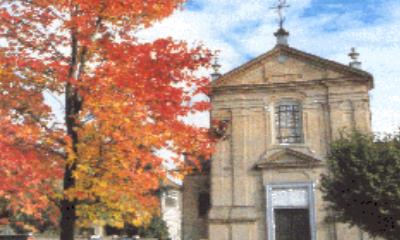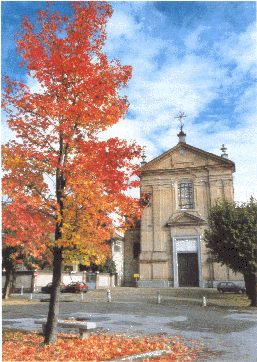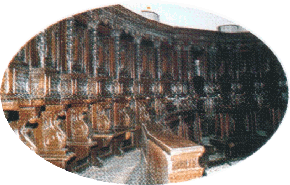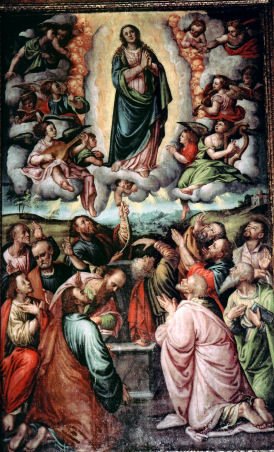
 Text by Ermanno Gardinali
Text by Ermanno Gardinali
The construction of St. Stephen’s church, consecrated in 1795, took several decades. The church that we see today was built on the remnants of an old church, whose rectory is still visible inside the current parish house.
The diverse architectural style is due to the multiple works carried out during its construction. In 1965 a bas-relief by the sculptor Cassino was placed on the church facade.  The bas-relief features Our Lady of the Rosary’s baroque altar, including the 15 Eucharist medallions and the wooden sculptures of St. Dominic and St. Catherine, St. Bovo’s altar opposite to it and the wooden choir, all coming from Our Lady of Graces’ church. Inside the church you can appreciate Giuseppe Giovenone’s wood panels portraying the Assumption of the Virgin (1573). Walking around you can admire the intricate mosaic floor from 1851, which covers the single nave. The church houses the tombs of five family members of Marquis Orsini Roma, from Milan, last feudal lord of Robbio. As you enter the church, take a look at the first chapel on the right-hand side, where you will find a stone with the names of Robbio’s priests in chronological order, starting from 1057.
The bas-relief features Our Lady of the Rosary’s baroque altar, including the 15 Eucharist medallions and the wooden sculptures of St. Dominic and St. Catherine, St. Bovo’s altar opposite to it and the wooden choir, all coming from Our Lady of Graces’ church. Inside the church you can appreciate Giuseppe Giovenone’s wood panels portraying the Assumption of the Virgin (1573). Walking around you can admire the intricate mosaic floor from 1851, which covers the single nave. The church houses the tombs of five family members of Marquis Orsini Roma, from Milan, last feudal lord of Robbio. As you enter the church, take a look at the first chapel on the right-hand side, where you will find a stone with the names of Robbio’s priests in chronological order, starting from 1057.
Altarpiece by Giuseppe Giovenone the Young (1524-1609), housed in the church of St. Stephen, Robbio (Pavia).
 This work is a large-sized altarpiece thought to be made by an unknown master of the Vercelli school in the 16th century. Previously arranged in the apse of the Our Lady of Graces’ church, is currently housed in the left aisle of St. Stephen’s church and it represents the most relevant historical work of Robbio, dating back to Liutprand, King of the Lombards’, era (approx. 800 A.D.). Our Lady’s of the Graces’ church was built in the 15th century, just like St. Peter’s church, where a remarkable fresco in Foppa’s style can be seen in the apse, painted by an unknown Lombard painter of the time, along the Via Francigena, which crossed Lomellina in the Middle Age.
This work is a large-sized altarpiece thought to be made by an unknown master of the Vercelli school in the 16th century. Previously arranged in the apse of the Our Lady of Graces’ church, is currently housed in the left aisle of St. Stephen’s church and it represents the most relevant historical work of Robbio, dating back to Liutprand, King of the Lombards’, era (approx. 800 A.D.). Our Lady’s of the Graces’ church was built in the 15th century, just like St. Peter’s church, where a remarkable fresco in Foppa’s style can be seen in the apse, painted by an unknown Lombard painter of the time, along the Via Francigena, which crossed Lomellina in the Middle Age.
Translated by Elena Ferrara



